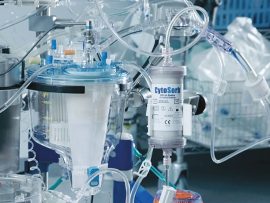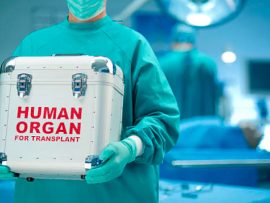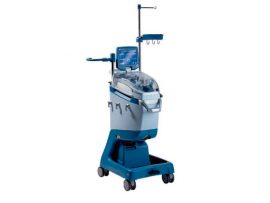Abstract Background. Withdrawal of life-sustaining therapy (WLST) performed in the circulatory determination of death (DCD) donors leads to cardiac arrest, challenging the utilization of the myocardium for transplantation. The rapid..
Lire la suiteAbstract Acute myocardial infarction-related cardiogenic shock (AMI-CS) carries a dismal prognosis. Short-term mortality is in the range of 40–50% [1]. Until recently, only treatment of the culprit lesion by percutaneous..
Lire la suiteAbstract Background Extracorporeal blood purification has been widely used in intensive care medicine, nephrology, toxicology, and other fields. During the last decade, with the emergence of new adsorptive blood purification..
Lire la suiteAbstract Venovenous bypass (VVB) is a technique used in liver transplantation (LT) to maintain hemodynamic stability and abdominal organ perfusion and thereby improve patient outcomes. Despite its perceived benefits, VVB..
Lire la suiteAbstract Background In lung transplantation (LTx) surgery, veno-arterial extracorporeal membrane oxygenation (VA-ECMO) can provide mechanical circulatory support to patients with cardiopulmonary failure. However, the use of heparin in the administration..
Lire la suiteAbstract Background: In lung transplantation surgery, extracorporeal life support (ECLS) is essential for safety. Various support methods, including cardiopulmonary bypass (CPB) and off-pump techniques, are used, with extracorporeal membrane oxygenation (ECMO)..
Lire la suiteAbstract Objectives There is accumulating evidence that blood pressure management might be associated with end-organ dysfunction after cardiac surgery. This study aimed to investigate the impact of intraoperative hypotension (IOH)..
Lire la suiteAbstract The physiologic impact of pulsatile flow (PF) on end-organ perfusion during cardiopulmonary bypass (CPB) is controversial. Using an intra-aortic balloon pump (IABP) to maintain PF during CPB for patients..
Lire la suiteAbstract Heart transplantation utilizing deceased after circulatory death (DCD) donors has expanded the donor pool through the use of ex vivo normothermic perfusion. Compared with brain death donation, the conventional..
Lire la suiteAbstract In donation after circulatory death (DCD) organ transplantation, normothermic regional perfusion (NRP) restores oxygenated blood flow following cardiac arrest and reverses warm ischemia. Recently, NRP has also been used..
Lire la suiteAbstract Artificial intelligence (AI) is a transformative technology with many benefits, but also risks when applied to healthcare and cardiac surgery in particular. Surgeons must be aware of AI and..
Lire la suiteAbstract Aims The aim of this trial was to compare the clinical effects of intraoperative haemoadsorption versus standard care in patients undergoing orthotopic heart transplantation (OHT). Methods and results In..
Lire la suiteAbstract Background The utilization of extracorporeal life support (ECLS) for intraoperative support during lung transplantation has increased over the past decade. Although veno-arterial extracorporeal membrane oxygenation (VA-ECMO) has recently emerged..
Lire la suiteAbstract Heart transplantation from donation after circulatory death (DCD) donors has the potential to substantially increase overall heart transplant activity. The aim of this report is to review the first..
Lire la suiteAbstract Mechanical circulatory support (MCS) as a bridge to lung transplant is an infrequent but accepted pathway in patients who have refractory end-stage pulmonary failure. The American Association of Thoracic..
Lire la suiteAbstract Tricuspid regurgitation (TR) is common after a heart transplant and is associated with worse clinical outcomes. The incidence ranges from 34% immediately after transplant to 20% by 10 years...
Lire la suiteAbstract Background: Highly sensitized pediatric patients awaiting heart transplantation experience longer wait times and thus higher waitlist mortality. Similarly, children less than 2 years of age have increased waitlist times and..
Lire la suiteAbstract Purpose: This study aimed to assess the necessity of routine intraoperative cell salvage in liver transplantations. Methods: A total of 327 liver transplants performed between 2014 and 2016 was..
Lire la suiteAbstract Severe acute hypercapnia is independently associated with increased adverse effects and intensive care unit mortality in mechanically ventilated patients. During the severe acute respiratory syndrome coronavirus 2 (COVID-19) pandemic,..
Lire la suiteAbstract Primary graft dysfunction is a feared complication and cause of mortality post–heart transplant. Primary graft dysfunction may require mechanical circulatory support, such as venoarterial extracorporeal membrane oxygenation, which carries..
Lire la suiteAbstract Primary graft dysfunction (PGD) after cardiac transplantation is a devastating complication with increasing frequency lately in the setting of donation after circulatory death (DCD). Severe PGD is commonly treated..
Lire la suiteAbstract PRINCETON, N.J., Sept. 11, 2023 (GLOBE NEWSWIRE) -- (NASDAQ: CTSO), a leader in the treatment of life-threatening conditions in intensive care and cardiac surgery using blood purification via its..
Lire la suiteAbstract People from socioeconomically distressed communities who underwent heart transplantation between 2004 and 2018 faced a 10% greater relative risk of experiencing graft failure and dying within five years compared..
Lire la suiteAbstract Traditional ice storage has been the historic standard for preserving donor’s hearts. However, this approach provides variability in cooling, increasing risks of freezing injury. To date, no preservation technology..
Lire la suite(Thanks to Navin Kumar for letting us share) Preface: Working as a perfusionist is a highly challenging and rewardingcareer path. The educational standards are high, and theprofession appeals to those..
Lire la suiteAbstract Objectives Viscoelastic assays, such as rotational (ROTEM), are used increasingly in cardiac surgery to guide transfusion decisions. After separation from (CPB), achieving rapidly is the main goal before chest closure. The authors hypothesized..
Lire la suiteAbstract With the implementation of the new allocation system in the United States on October 18, 2018, patients requiring temporary mechanical circulatory support (tMCS) have the highest priority, a shorter..
Lire la suiteAbstract Background Extracorporeal membrane oxygenation (ECMO) is a recognized method of support in patients with severe and refractory acute respiratory distress syndrome (ARDS) caused by SARS-CoV-2 infection. While veno-venous (VV)..
Lire la suiteAbstract Elevated levels of neutrophil extracellular traps (NETs) have been reported in primary graft dysfunction, making methods to reduce or remove them highly valuable. The mechanisms behind primary graft dysfunction..
Lire la suiteAbstract There are minimal data on the use of venoarterial extracorporeal membrane life support (VA-ECLS) in adult congenital heart disease (ACHD) patients presenting with cardiogenic shock (CS). This study sought..
Lire la suite

















